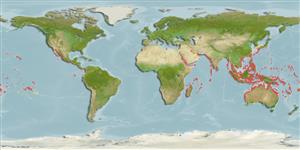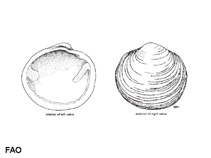Anodontia edentula (Linnaeus, 1758)
Toothless lucine| Native range | All suitable habitat | Point map | Year 2050 |

|
| This map was computer-generated and has not yet been reviewed. |
| Anodontia edentula AquaMaps Data sources: GBIF OBIS |
Classification / Names প্রচলিত নাম সমূহ | প্রতিনাম সমূহ | CoL | ITIS | WoRMS
Bivalvia | Lucinida | Lucinidae
Environment: milieu / climate zone / গভীরতার পরিসীমা / distribution range বাস্তুসংস্থান
; গভীরতার পরিসীমা 0 - 20 m (সূত্র 348). Tropical
Distribution দেশ সমূহ | এফ এ ও এলাকাসমূহ | বাস্তুতন্ত্র | দৃষ্টিগোচর | প্রচলন
Indo-Pacific: from East and South Africa, including Madagascar and the Red Sea, to eastern Polynesia and Hawaii and from southern Australia to northern Japan.
Length at first maturity / আকৃতি / Weight / Age
পরিপক্কতা : Lm ? range ? - ? cm Max length : 9.0 cm SHL পুরুষ/ লিঙ্গ অনিধর্ারিত ; (সূত্র 74338); common length : 5.0 cm SHL পুরুষ/ লিঙ্গ অনিধর্ারিত ; (সূত্র 348); সবের্াচ্চ প্রকাশিত ওজন : 210.00 g (সূত্র 74338)
Often buried just under the surface of the sandy-muddy substrates near mangrove areas (Ref. 80041). Occurs in mudflats. Abundant shells are present among shell debris in shallow tidal channels within lagoons (Ref. 101158). Deposit-feeder (Ref. 348). Suspension feeder (Ref. 108437).
Life cycle and mating behavior পরিপক্কতা | প্রজনন | ডিম ছাড়া | Eggs | ডিম্বধারন ক্ষমতা | Larvae
Members of the class Bivalvia are mostly gonochoric, some are protandric hermaphrodites. Life cycle: Embryos develop into free-swimming trocophore larvae, succeeded by the bivalve veliger, resembling a miniature clam.
Main reference
সূত্র সংখ্যা | সমম্বয়কারী | সহযোগী
Poutiers, J.M. 1998. (সূত্র 348)
IUCN Red List Status
(সূত্র 130435: Version 2024-2)
CITES status (সূত্র 108899)
Not Evaluated
CMS (সূত্র 116361)
Not Evaluated
Threat to humans
Human uses
মৎস্য: বাণিজ্যিক
| FishSource |
হাতিয়ার
আরো তথ্য
ট্রফিক বাস্তুতন্ত্র
খাদ্যসামগ্রী
পথ্য উপাদান
খাদ্য গ্রহণ
Food rations
শিকারী প্রাণী সমূহ
পথ্য উপাদান
খাদ্য গ্রহণ
Food rations
শিকারী প্রাণী সমূহ
বাস্তুসংস্থান
Population dynamics
বৃদ্ধি
Max. ages / sizes
Length-weight rel.
Length-length rel.
Length-frequencies
Mass conversion
নির্বাচন
প্রাচুর্য
Max. ages / sizes
Length-weight rel.
Length-length rel.
Length-frequencies
Mass conversion
নির্বাচন
প্রাচুর্য
Life cycle
Distribution
Human Related
Aquaculture profiles
Stamps, coins, misc.
Stamps, coins, misc.
Outreach
Taxonomy
সূত্র সংখ্যা
ইন্টারনেট সুত্র
BHL | BOLD Systems | CISTI | DiscoverLife | FAO(Publication : search) | Fishipedia | GenBank (genome, nucleotide) | GloBI | Gomexsi | Google Books | Google Scholar | Google | PubMed | জীবন বৃক্ষ | Wikipedia (Go, অনুসন্ধান ) | জুলজিকাল রেকর্ড
Estimates based on models
Preferred temperature
(Ref. 115969): 24.1 - 29.3, mean 28.3 (based on 3924 cells).
Price category
(সূত্র 80766):
Unknown.



